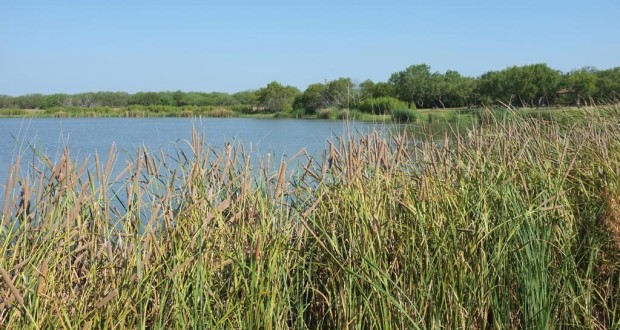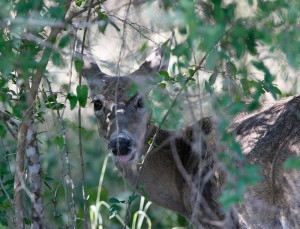The park has two sections. The South Shore area, near the dam and spillway, is for day use only, with little more than a boat ramp and shore for fishing. The larger Calliham area several miles down the road is on a peninsula that juts out into the lake.
Within the Calliham section, there’s a quiet 75-acre lake rimmed in cattails. One end of the lake is a watery grave for trees weathered to a silvery finish. The alligators that swim in its shallows are about as far west as they are commonly found.
A short trail begins near the small lake as “Hawk Alley” and winds through a scrubby landscape of mesquite and acacia before crossing the road and changing its name. White-tailed deer often graze at the edges of the forest. Flocks of Rio Grande Turkeys slip through the thorny thicket, and cottontail rabbits blaze paths through the high grass. The brush is home, too, for javelina, coyotes, skunks and other small animals.
The lakes and savannah attract a variety of wading and migratory birds, along with Black Vultures that scavenge along the shores and Roadrunners that dart quickly into the brush. Because of its southern location, the park attracts some species more commonly found in Mexico. The Parks and Wildlife Department birding guide for Choke Canyon describes the variety of species found there:
Permanent residents in the brushy uplands include Long-billed and Curve-billed Thrashers, Olive Sparrows, Wild Turkeys, Common Ground-Doves, Cactus Wrens and Pyrrhuloxia. In the summer, look for Audubon’s Orioles (rare but regular), Brown-crested and Vermillion Flycatchers. Cave Swallows nest under the roofs of shelters in the picnic and camping areas. The [75-acre lake] is a good area for Mottled Ducks, Black-bellied Whistling Ducks, Anhinga …, cormorants, herons, egrets, gulls and terns.
Drive further west down Highway 72 and you come to the scattered pieces of the James E. Daughtery Wildlife Management Area. There are several boat ramps accessing the western end of the reservoir, but the focus of the Wildlife Management Area is more on hunting, with most of its areas accessible only to those with permits. Down the road from the main gate of the management area is a wild trail that follows a slough along the lake and a short peninsula crowded with the skeletons of large trees. Egrets, herons and other wetland birds forage there along the shores.


You must be logged in to post a comment.